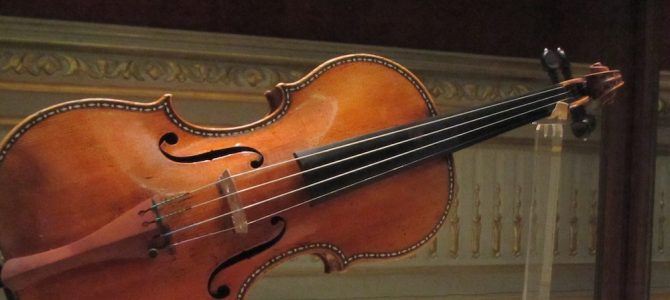
A violin is perhaps one of the trickiest instruments to play. It has a delicate sound that can easily become screechy, or scratchy. It requires a good deal of coordination, finger strength, and technique to get just right. But when you do get it right—when that vibrato finally clicks, or the phrasing on that Mendelssohn piece finally falls into place—you feel like you’re walking on air.
The violinist is always ultimately responsible for his or her sound. But the make of a violin has a lot to do with its tone, projection, and quality. A poorly made violin sounds cheap. It’s hollow, indistinct, and—for lack of a better term—“bleh.”
As a young violinist, I was told the lore and glory surrounding eighteenth-century Stradivarius instruments. They were said to sound angelic, full of resonant warmth and glorious clarity. They were almost mythological—and their prices, indeed, were otherworldly. The current price record for a Stradivarius is $15.6 million, although it was rumored that a Stradivarius viola sold for $45 million in 2014.
All that may change. According to a couple new studies released by acoustic researcher Claudia Fritz, both skillful musicians and practiced audiences cannot tell the difference between the Stradivarius violin and newer counterparts. (You can listen to a Stradivarius and compare it to a new violin inside this NPR article.)
This Revelation Is Huge For The Violin World
First, I want you to consider the impact of this revelation. For centuries, violin players and makers wondered at the unique and lasting greatness of the Italian Stradivarius family, and the instruments they created.
The study’s author doesn’t think these new findings will affect their sale price. But how could they not? Of course we enjoy beautiful antique instruments. But there was a fabled glory and quality surrounding the Stradivarius violins that made them especially valuable. This study, at least until new findings arrive, crushes some of that mythologizing.
Of course, on the other hand, these new findings democratize the music world. The musician who buys a high-quality new instrument has the same chance at glorious sound as a professional with a wealthy patron. That makes Itzhak Perlman-esque prestige more tangible, reachable, than it may otherwise seem. (Even if it’s still light years away from your average violinist.)
Violin makers now can believe they can achieve greatness that they heretofore saw as beyond their reach. As Fritz notes, “In general, [violin] makers — especially young makers — are delighted. And old makers as well, because old [violin] makers, they feel like they are liberated, that’s what they told me … because they feel less pressure to copy Strad.”
Some Caveats and Questions Worth Considering
There are some caveats worth mentioning.
- The violins used in this study could not have been representative. Perhaps there’s more fluctuation in the instruments’ value than we’ve heretofore understood. Are certain Stradivarius violins, while still immensely valuable and high quality, not as “fine” as other counterparts?
- The difference in preferred sound could have to do with the violinists, as well: this study didn’t test this possibility soundly, because according to its author, “such an experiment would have required each listener to listen to nine pairs of violins twice. … Comparing 36 repetitions of the same piece, they decided, would be too difficult.”
- It could also be that Stradivarius instruments have deteriorated over time. I was always led to believe that an instrument’s wood requires a degree of maturation before it reaches its fullest potential. Could it be, however, that the opposite is true? That after a period of time (say, hundreds and hundreds of years), an instrument can deteriorate? I’m no scientist. But it seems plausible.
- We don’t know yet why the new instruments appeared to sound better and project more. Is this a recent phenomenon? Perhaps new technologies and manufacturing practices are offering us better, higher-quality instruments. But it could also be that we’ve always inflated the value of Stradivari instruments. This seems unlikely to me—people don’t spend millions of dollars because of mere myth—but it could be possible, I suppose.
Here’s another question of the study, posed by violinist Stéphane Tran Ngoc, who took part in Fritz’s first test:
… [H]anding a performer an unfamiliar instrument and assessing how good they make it sound might not do it justice. ‘It’s frequently necessary to spend much more time on old instruments in order to know how to make them sound good,’ he says. ‘A great old Italian violin will develop and will sound better and better as it is played, unlike many of the modern instruments.’
He uses an old instrument himself. And when he played it while participating in the tests, he (and others) felt it sounded better than the other violins. But ‘of course that’s unfair,’ he adds, ‘as I have played on my instrument for 25 years and know it very well.’
It also seems there’s room here to conduct further studies on the discrepancies and similarities between old and new string instruments. The human ear can only pick up so much. Could recorded samples of music from the new and old instruments tell us something about their similarities, strengths, and divergences?
This Still Changes The Violin World, At Least For Now
Regardless, at least at present, this signals a shift in the violin world. If nothing else, it shifts the myths and legends surrounding us. Stradivarius instruments are beautiful no matter what—but it’s their sound that has made them legendary.
Fritz believes the violins will continue to be esteemed for their artistic quality. “It’s a piece of art. I mean, they are beautiful. We can’t deny that,” she says. For example, she says, “famous people want to pay full price for a Picasso rather than the copy, even if nobody will make the difference by eye. [It’s] the same for instruments.”
But when I buy a violin for my daughter someday, my decision-making may be altered by this finding. Normally, I would say “older is better.” And I still love the look of an antique violin. But now, I’ll give new violins a greater chance than I otherwise would. Because who knows? Maybe they’ve got angelic sound, after all.









